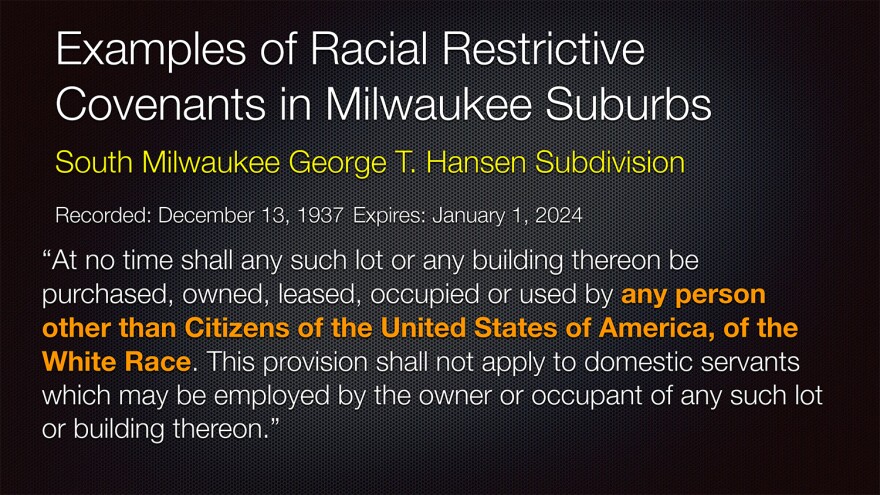“Segregation is not an accident,” according to Reggie Jackson, the head griot for America's Black Holocaust Museum.
“There’s this idea that people self-segregate, but the reality is that there’s never really been self-segregation in Milwaukee,” Jackson says. “The segregation that we have, in terms of people of color, was created by a variety of different in institutions and individuals.”
Jackson says the barriers erected and tools used to support segregation in metro Milwaukee have ranged from redlining and restrictive covenants, to government and industry policies, to societal attitudes.
Redlining

“Redlining came about as a result of actions by the federal government,” Jackson explains. Residential security maps were drawn, which are more commonly known as redlining maps, by the Home Owners’ Loan Corporation in the late 1930's to evaluate the riskiness of mortgages.
>> Find Your Neighborhood On A Redlining Map
There were four different designations: Green = best, blue = still desirable, yellow = definitely declining and red = hazardous.
Jackson explains that it was practically impossible to get mortgages and insurance in the red areas.
The 1938 residential security map of the Milwaukee area had 19 areas redlined for a variety of reasons – heavy industry, polluted water ways, lack of modern sewage, old housing stock.
Jackson points out that three of those areas were created because of who lived there. One area was designated red because of the “detrimental influence” of Polish residents, another area was red due to the “infiltration of Mexicans.” Milwaukee’s third race-related red zone was labeled so because of “Negro slum residents and lower-type Jews.”

Living in a red area made it difficult to achieve any level of economic success, Jackson says. “They would maintain themselves as renters; they would never become homeowners.” He adds that, "Close to 100% of blacks lived in redlined areas.”
#SuburbsSoWhite
Zoning laws and racial restrictive covenants were other mechanisms used to segregate communities.
“The federal government mandated that the federal housing authority create policies to direct realtors, bankers and mortgage lenders on how to deal with people from different groups,” Jackson explains. He says the government basically gave them the tools to utilize racial restrictive covenants and recommended their use.
16 of Milwaukee's 18 suburbs had racial restrictive covenants.
Jackson points to a UWM study that said of the 18 Milwaukee suburbs, 16 had racial restrictive covenants.
As these covenants became popular in the 1920's, “[they] were attached to the deed as you purchased a property,” Jackson says. As Milwaukee’s suburban communities were being created, many homes there had racial restrictive covenants.
>> Check your deed. Does it have a racial restrictive covenant?

Jackson says that the majority of the covenants he has seen say something along the lines of: “This property cannot be occupied by people other than the white race.”
“Many of them specifically stated that blacks could not occupy these spaces.” He points out that some did had a caveat for domestic workers, who worked for the owner of the property.
“So, these became the primary tools to keep blacks out of certain neighborhoods,” Jackson says. “If you were a person who purchased that property, you had to abide by the terms of that racial restrictive covenant.”
The covenants had start and end dates, but in many cases the end dates were extended. “Many were created in the 1920's, 1930's, 1940's and were extended into the 2000's,” Jackson says. He saw one in South Milwaukee that wasn't set to expire until 2024.

All these techniques to limit where black people could live in metro Milwaukee came to ahead when the open housing marches took place in town and the federal government passed the Fair Housing Act of 1968. Jackson says the act outlawed redlining and racial restrictive covenants and created a mechanism for people to file complaints for being discriminated against in housing.
However, Jackson says that data from 1975 showed that the rate of African Americans living on Milwaukee's south side were still in the single digits. “So, blacks still did not move into the communities where white persons lived. The communities that [black people] began to move into pretty much became all black as whites left those communities,” Jackson says.

As for today, Jackson says, “In the City of Milwaukee, we have an open housing ordinance, we have a federal law that bars discrimination in housing, but we don’t have the machinery to enforce it or the wherewithal… If this is something the city really desires, then there should have been strict enforcement it. But that’s never really existed in the City of Milwaukee.”
For more on this topic, explore our Project Milwaukee: Segregation Matters series.








